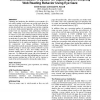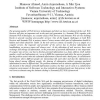770 search results - page 58 / 154 » Using web browser interactions to predict task |
BMCBI
2008
14 years 10 months ago
2008
Background: Amino acid sequence probability distributions, or profiles, have been used successfully to predict secondary structure and local structure in proteins. Profile models ...
CN
2000
14 years 9 months ago
2000
The Stanford Power Browser project addresses the problems of interacting with the World-Wide Web through wirelessly connected Personal Digital Assistants (PDAs). These problems in...
CHI
2005
ACM
15 years 10 months ago
2005
ACM
Capturing and analyzing the detailed eye movements of a user while reading a web page can reveal much about the ways in which web reading occurs. The WebGazeAnalyzer system descri...
IIWAS
2007
14 years 11 months ago
2007
The growing number of Web Services technologies and their use have revolutionized the web. Web Services will play an important role in the next web generation (i.e. Semantic Web) ...
PEPM
2007
ACM
15 years 4 months ago
2007
ACM
The event-driven programming style is pervasive as an efficient method for interacting with the environment. Unfortunately, the event-driven style severely complicates program mai...


